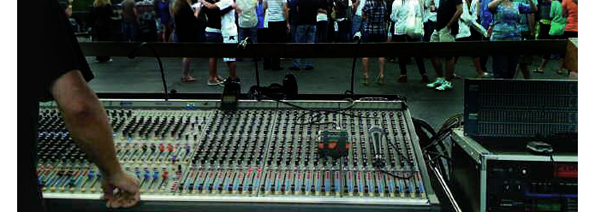In my perhaps too frequent visits pro audio forums, I regularly read about weekend warriors who have just acquired their first DSP (digital signal processor) system controller and are seeking to understand how it’s auto RTA (real-time analyzer) function can help provide better performance out of their portable sound system.
Invariably, the DSP unit is pressed into service for the first gig, a measurement microphone is attached, and some signal (usually pink noise) is run through the rig while the auto RTA is allowed to mess around with the 31-band input graphic EQ. The resulting EQ curve is often alien and arbitrary, with huge boosts in the low end of the spectrum and alternating smaller boosts and cuts in the mid and high frequencies.
The system operator then does what he should have done in the first place: uses his ears and brain to manually set the DSP’s graphic EQ back to some semblance of normalcy.
The next show is in a different room, with the measurement microphone in a different spot, and the process repeats itself with completely different but equally wrong results.
The inability of this process to arrive at a meaningful, consistent, and sonically pleasing result is what sends these enterprising sound techs to the LAB with questions, so let’s set the record straight: the very concept of auto RTA has serious flaws.
Its continued use by engineers worldwide reflects a fundamental misunderstanding of what makes a measurement system and how it is used. Unfortunately there’s nothing simple about proper system measurement.
The most important thing to understand is the the difference between what can be corrected with EQ – and what cannot.
The first aspect that must be considered is the acoustic environment in which the sound system will be operating. No matter how much processing is available, or how adept the engineer is at using it, there is no electronic way to correct for either improper loudspeaker positioning or for a room that has lousy acoustics from the start.
In the real world we all have to deal with some of both, but nasty rooms are the bane of any system engineer’s existence.
It is possible to lessen the effects of a room that is extremely reverberant at, say, 500 Hz, by notching that frequency on an equalizer, but this is a double-edged sword. Removing that frequency from the PA will make it less likely to excite the room’s natural reverberance, but 500 Hz is also where a lot of guitar and drum tone lives, so axing it can also make the system sound weak.
There may be an increase in sound quality, but the underlying problem hasn’t been addressed, and any additional clarity is simply the result of going from terrible to not quite as bad.
Arraying loudspeakers so they keep sound off the walls and ceiling, reducing stage volume, reducing the volume of the mains – these kinds of changes and compromises can make a big difference where all the EQ in the world cannot and they all address the real issue: too much sound energy in the wrong places.
I find too many bands and sound companies creating problems for themselves through loudspeaker placement because “that’s the way we’ve always done it,” failing to take into account that no sound system is a one-size-fits-all solution.
















